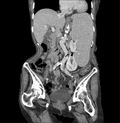Abstract
An 85‐year‐old woman presented with pain and a palpable mass in her left flank. Abdominal computed tomography revealed massive splenomegaly and para‐aortic lymphadenopathies. Bone marrow biopsy showed CD79a, CD20, and bcl‐2‐positive atypical lymphocytes, which led to the diagnosis of splenic marginal zone lymphoma.
Keywords: massive splenomegaly, splenic marginal zone lymphoma
The causes of massive splenomegaly are hematologic diseases, malignancies, infection, and infiltrative conditions. When seeing massive splenomegaly, hematologic diseases, especially malignant diseases, should be ruled out first.

1. CASE
An 85‐year‐old woman with good appetite, no fever or weight loss visited our hospital because of left flank pain. Physical examination revealed a palpable mass with tenderness in her left flank, no palpable lymph nodes in any area of the body, and no other abnormal findings. Blood examination revealed: white blood cell count: 6.1 × 109/L, hemoglobin: 106 g/L, platelets: 9.7 × 109/L, soluble interleukin‐2 receptor 4,006 U/mL, and no abnormalities in liver function, including lactate dehydrogenase. Abdominal contrast‐enhanced computed tomography revealed massive splenomegaly of >20 cm without mass lesion, and para‐aortic lymphadenopathies (Figure 1, Videos S1 and S2). Bone marrow biopsy revealed proliferation of atypical lymphocytes, and immunostaining was positive for Cluster Designation (CD)79a, CD20, and bcl‐2, which led to a diagnosis of splenic marginal zone lymphoma (SMZL).
FIGURE 1.

Abdominal contrast‐enhanced computed tomography findings. Abdominal contrast‐enhanced computed tomography images showing massive splenomegaly with a dilated splenic vein (arrowhead) and enlarged para‐aortic lymph nodes (arrows)
SMZL is a rare subtype of non‐Hodgkin lymphoma showing splenomegaly and lymphocytosis. 1 The accurate diagnosis of SMZL is delayed because it does not show remarkable clinical symptoms and aggressive clinical courses. 1 The causes of massive splenomegaly are leukemias, non‐Hodgkin lymphoma, myelofibrosis, metastatic cancer, primary splenic tumors, infection, autoimmune hemolytic anemia, β‐thalassemia major, megaloblastic anemia, hereditary spherocytosis, and infiltrative conditions. 2 When seeing massive splenomegaly, hematologic malignant diseases should be ruled out first.
CONFLICT OF INTEREST
The authors have declared no conflict of interest.
AUTHOR CONTRIBUTIONS
Tago M was involved in the conception of the study, and in the literature search and drafting the manuscript. Fujiwara M, Tokushima M, Yamashita S, Tokushima Y, and Aihara H were involved in the conception of the study and drafting the manuscript. Nakashima T, Makio S, and Hirakawa Y were involved in the literature search and clinical care of the patient. Yamashita SI was involved in the conception of the study and revising the manuscript.
ETHICAL APPROVAL
This manuscript conforms to the provisions of the Declaration of Helsinki in 1995 (as revised in Brazil 2013).
CONSENT
Written informed consent to publish this report was obtained from the patient in accordance with the journal's patient consent policy.
Supporting information
Video S1
Video S2
Supplementary Material
ACKNOWLEDGEMENT
We thank Jane Charbonneau, DVM, from Edanz (https://jp.edanz.com/ac) for editing a draft of this manuscript.
Tago M, Fujiwara M, Nakashima T, et al. Massive splenomegaly requiring differential diagnosis of hematologic malignancies. Clin Case Rep. 2022;10:e05512. doi: 10.1002/ccr3.5512
Funding information
There is no funding for this article
DATA AVAILABILITY STATEMENT
The data that support the findings of this study are available from the corresponding author upon reasonable request.
REFERENCES
- 1. Santos TSD, Tavares RS, Farias DLC. Splenic marginal zone lymphoma: a literature review of diagnostic and therapeutic challenges. Rev Bras Hematol Hemoter. 2017;39(2):146‐154. doi: 10.1016/j.bjhh.2016.09.014. Epub 2016 Dec 22. PMID: 28577652; PMCID: PMC5457460. [DOI] [PMC free article] [PubMed] [Google Scholar]
- 2. Clark SM, Samareh‐Jahani F, Chaudhuri MA. Massive splenomegaly and pancytopenia: it's a hairy situation. Cureus. 2020;12(12):e12237. doi: 10.7759/cureus.12237. PMID: 33500860; PMCID: PMC7819457. [DOI] [PMC free article] [PubMed] [Google Scholar]
Associated Data
This section collects any data citations, data availability statements, or supplementary materials included in this article.
Supplementary Materials
Video S1
Video S2
Supplementary Material
Data Availability Statement
The data that support the findings of this study are available from the corresponding author upon reasonable request.


